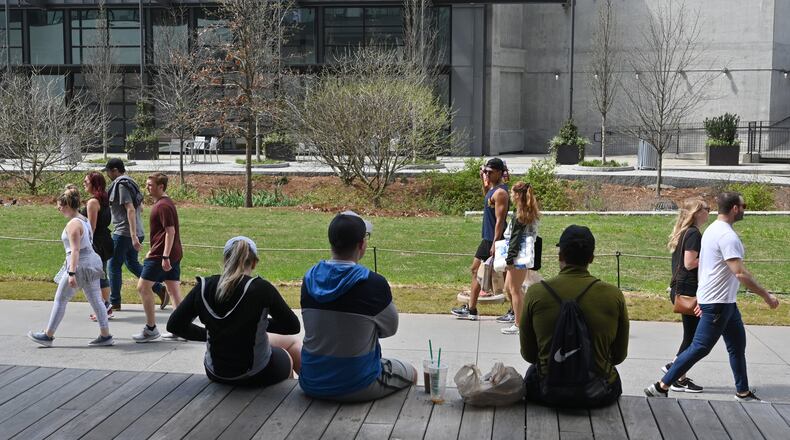Once again, Atlanta residents have shown their love for parks. On May 24, nearly 83 percent of voters supported $213 million in bond funding to construct, improve and repair facilities for public safety, parks and recreation. This commitment is just the most recent step in a multi-decade journey to position Atlanta as a national leader in recreation and the outdoors.
Twenty years ago, Trust for Public Land (TPL) and the Urban Land Institute (ULI) released “Inside City Parks,” one of the first assessments of urban park systems across the country. The news for Atlanta was not good. Among the 25 largest cities, Atlanta had the smallest percent of its land dedicated to public parks.
Credit: Teryl Jackson
Credit: Teryl Jackson
That report started a movement. I was working for Congressman John Lewis at the time, and local staff from TPL approached him about endorsing an effort to get Atlanta out of the basement by investing in parks and greenspace across the city. Diverse community and conservation organizations created the Park Atlanta Rescue Coalition (PARC), with an ambitious agenda for making Atlanta a parks leader.
Congressman Lewis signed on, and candidates for Mayor and City Council soon followed. Atlanta’s parks movement was born.
When Shirley Franklin was elected mayor, she became a powerful voice for parks, creating a Parks and Greenspace Taskforce that produced six big ideas. The city soon got behind the most promising of those ideas: creating a parks district with a dedicated revenue stream to acquire land, invest in facilities and improve park operations and maintenance. Despite significant political investment in the parks district, it did not come to fruition. But another promising park idea would transform our city.
I first learned of the Beltline when Ryan Gravel and Cathy Woolard garnered Congressman Lewis’s support to fund a feasibility study of transforming a 22-mile loop of largely abandoned and underutilized rail lines into a transit corridor that would revitalize much of Atlanta’s urban core.
Inspired by Ryan’s big idea, TPL produced “The Beltline Emerald Necklace,” a vision for adding more than 1,400 acres of parks (including Westside Park, Historic Fourth Ward Park, and Boulevard Crossing Park) along the transit line, linked by a trail championed by the PATH Foundation. By the sheer ambition of its vision, the Atlanta Beltline – now led by Atlanta Beltline Inc. – will stand as one of the extraordinary American park efforts of the 21st century.
Over the next decade, even through the fiscal challenges that would come with economic downturns, Atlanta – including the city’s innovative Department of Watershed Management – continued to invest in projects like Cook Park. Westside Park and Lake Charlotte Preserve.
Today, our work to position Atlanta as a model for parks and greenspaces is paying off, as evidenced by TPL’s 2022 ParkScoreTM Index. Atlanta climbed 22 spots, from No. 49 to No. 27, making our city the biggest mover this year. The index, which evaluates park systems in the 100 most populous U.S. cities, revealed that 77 percent of Atlanta residents live within a 10-minute walk of a park. That’s a big increase from 2010 when our number was below 50 percent.
But this work didn’t happen overnight, and the city didn’t do it alone.
Those PARC organizations don’t just advocate. The PATH Foundation, Conservation Fund, Trees Atlanta, West Atlanta Watershed Alliance, park conservancies, Park Pride and others have rolled up their sleeves to work with the city and residents to get things done. I am proud to serve alongside them today as TPL’s Georgia state director.
For our part, Trust for Public Land is excited to help:
- Build the Chattahoochee RiverLands; working with the city, community groups and park organizations to establish a five-mile waterfront park in Atlanta.
- Create a 48-mile camp and paddle trail, starting at Standing Peachtree Greenspace and providing a 4-day, 3-night outdoor experience in the heart of metro Atlanta.
- Continue to transform school sites into Community Schoolyards – student-designed outdoor learning spaces during school hours, neighborhood parks when school is out.
As ParkScore and the recent bond referendum demonstrate, Atlanta is becoming a park city. It is exciting to walk the Beltline, or explore the new parks that open each year.
But Mayor Andre Dickens says we are not done yet; “(M)ake room for Atlanta at the top.” Getting to the top will require providing park access to the more than 100,000 Atlanta residents who do not live within a 10-minute walk of a park. Continuing to address historic inequities in park access and amenities. Implementing big projects like South River Forest and the RiverLands. And, perhaps most importantly, making the significant investment in maintenance needed to care for all of our parks.
Atlanta’s parks movement has accomplished quite a lot over the past 20 years. Our city no longer ranks near the bottom. With continued leadership, investment and collaboration, we can reach the top.
George Dusenbury is Georgia state director of the Trust for Public Land. He previously led Park Pride and was Atlanta Parks Commissioner.
About the Author
Keep Reading
The Latest
Featured




